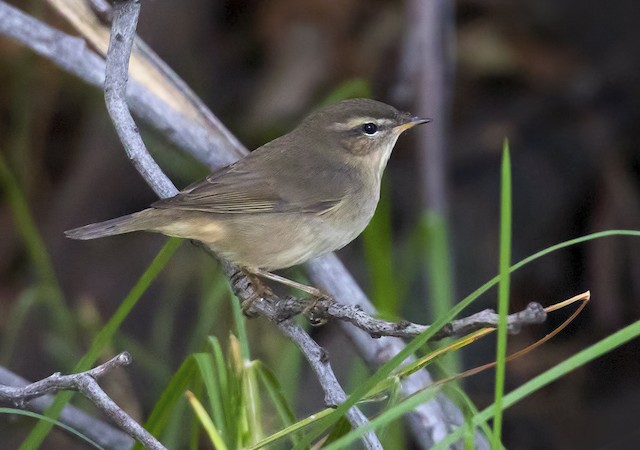Coyote Point Marsh, San Mateo County, CA (37.583755,-122.3164773)
10 October 2017
Joseph Morlan
Photo © Gail West. All rights reserved.
 Used by permission.
Used by permission.Dusky Warbler (Phylloscopus fuscatus)
Coyote Point Marsh, San Mateo County, CA (37.583755,-122.3164773)
10 October 2017
Joseph Morlan
Photo © Gail West. All rights reserved. Used by permission.
Used by permission.
This Dusky Warbler was originally found 8 October 2017 by Logan Kahle and Bob Toleno. I tried without success on the morning of 9 October. On 10 October I was back about 9:30am and almost immediately I heard what I thought was the Dusky Warbler chipping in tall weeds just north of the pump station in an area where the bird had been seen previously. However the chipping notes soon stopped without offering visual confirmation. As more birders arrived we heard the chipping several times but never got a visual. Eventually Adam Dudley and Dorian Anderson glimpsed the Dusky Warbler across the channel but Jacob Kirkland and I were distracted and looked at the wrong bird. After several hours, I was about to give up when Jacob ran back to get me saying that the bird had just been seen about 50 yards north near a large metal drainage pipe. There we met Patrick Baglee who had just located the Dusky Warbler and we finally got good views. We were joined by John Luther, Gail West, and Kent Forward. There we had intermittent views for about 45 minutes. This individual was a real skulker spending most of its time crawling on the ground in the grass. Gail West's superb photo taken while we were watching the bird is included here by permission.
Description
The following description is based on memory and on photos:
A small drab warbler with no wing-bars but showing a prominent pale supercilium which was narrow but well defined in the supraloral and expanding slightly behind the eye with a blended tan cast at the rear. The upperparts were solid brown with a slight grayish-olive cast, somewhat duller than I was expecting. Small narrow pale eye-crescents set off the dark eye. The ear coverts were gray-brown with faint streaking. The underparts were pale with an extensive brown-tan wash on sides and flanks. The yellowish-buff undertail coverts were distinctive. The tail was dark appearing square tipped when folded but slightly rounded when spread. The bill quite short and finely pointed with a yellow-orange base to the lower mandible. The feet and legs were dull brownish. The distinctive call was a rapid series of sharp notes similar to the common call of Lincoln's Sparrow (Melospiza lincolnii) but slightly lower and harsher.
Identification
The drab brown upperparts and lack of wing-bar help distinguish this species from Arctic/Kamchatca Leaf-Warbler (P. borealis/examinandus) while the thin bill, crisply defined lore pattern, drab rear supercilium, and dull leg color help distinguish it from the similar Radde's Warbler (P. schwarzi). Yellow-streaked Warbler (P. armandii) is similar but has white rear supercilium contrasting with dark eyeline. Smoky Warbler (P. fuligiventer) similar but darker with all dark bill and undertail coverts. Radde's, Yellow-streaked and Smoky Warblers unrecorded in North America, the latter two confined to central Asia.
Subspecies
Two races currently recognized. This is presumably nominate P. f. fuscatus which ranges across Siberia to the Russian Far East. P. f. robustus ranges from China to SE Asia and is characterized by larger size and yellowish tinge on its belly. Race weigoldi now considered to be a race of Smoky Warbler.
Discussion
California has 16 previously accepted Dusky Warbler records including one in San Mateo County last year. This fall has been exceptionally good for this species in California with a total of four individuals reported thus far including this one, two in Los Angeles County, and one in San Diego County.